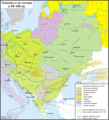Fișier:Slav-7-8-obrez.png

Mărimea acestei previzualizări: 544 × 599 pixeli. Alte rezoluții: 218 × 240 pixeli | 436 × 480 pixeli | 698 × 768 pixeli | 930 × 1.024 pixeli | 1.860 × 2.048 pixeli | 3.051 × 3.359 pixeli.
Mărește rezoluția imaginii (3.051 × 3.359 pixeli, mărime fișier: 339 KB, tip MIME: image/png)
Istoricul fișierului
Apăsați pe Data și ora pentru a vedea versiunea trimisă atunci.
| Data și ora | Miniatură | Dimensiuni | Utilizator | Comentariu | |
|---|---|---|---|---|---|
| actuală | 12 august 2023 18:13 |  | 3.051x3.359 (339 KB) | Gyalu22 | Reverted to version as of 13:16, 23 October 2022 (UTC) Look at the atlas, don't do your own research |
| 1 iunie 2023 20:43 |  | 3.051x3.359 (309 KB) | Shibbolet3579 | enice was still in the Byzantine Empire at this time. Avars were also present around Vienna and in central Transylvania, evidenced by graves & toponyms. There was a linguistic contact between Albanians and Vlachs, evidenced by the non-Slavic words present in both languages. Placed the Etelköz of the Magyars and the Crimean byzantine Greeks. South-Slavic toponyms (as Trnava for "tip, hillock, mound") evidenced a South-Slavic presence in southern Transylvania. Concerning the Eastern romance spe... | |
| 23 octombrie 2022 16:16 |  | 3.051x3.359 (339 KB) | Gyalu22 | Reverted bad faith edit, restored to version as of 26 July 2011. The Westermanns Atlas is an irrelevant source for the previous map, as only the Southern Carpathians are shown as possibly inhabited by the Wallachians. | |
| 28 aprilie 2014 18:09 |  | 3.051x3.359 (302 KB) | Spiridon Ion Cepleanu | Bulgarian kingdom & east-romance vlachs according with the universitary atlases of history and the Grosser Atlas zur Weltgeschichte, dir. Hans-Erich Stier, Westermann, 1985, ISBN 3-14-10-0919-8, pp. 50, 55-57, 61 & 64. | |
| 26 iulie 2011 21:27 |  | 3.051x3.359 (339 KB) | Koryakov Yuri | The map's resolution is drastically decreased. Undo | |
| 26 iulie 2011 07:53 |  | 544x599 (329 KB) | Spiridon Ion Cepleanu | On the original version of this map, the eastern romance language-spoken populations ("Vlachs" or "Volokhs") are draw only in a little area around Sredets (today Sofia), according with only one of the POVs, called "Röslerian" (since Eduard Robert Rösler | |
| 10 martie 2008 16:52 |  | 3.051x3.359 (339 KB) | Koryakov Yuri | {{Information |Description= |Source= self-made |Date=March 2008 |Author= Koryakov Yuri |other_versions= }} == Licensing == {{self|cc-by-sa-3.0}} Category:Maps of the history of Russia in Russian [[Category:Maps |
Utilizarea fișierului
Următoarele pagini conțin această imagine:
Utilizarea globală a fișierului
Următoarele alte proiecte wiki folosesc acest fișier:
- Utilizare la ar.wikipedia.org
- Utilizare la arz.wikipedia.org
- Utilizare la azb.wikipedia.org
- Utilizare la ba.wikipedia.org
- Utilizare la be-tarask.wikipedia.org
- Utilizare la be.wikipedia.org
- Utilizare la bg.wikipedia.org
- Utilizare la ce.wikipedia.org
- Utilizare la cs.wikipedia.org
- Utilizare la cv.wikipedia.org
- Utilizare la da.wikipedia.org
- Utilizare la de.wikipedia.org
- Utilizare la en.wikipedia.org
Vizualizați utilizările globale ale acestui fișier.

